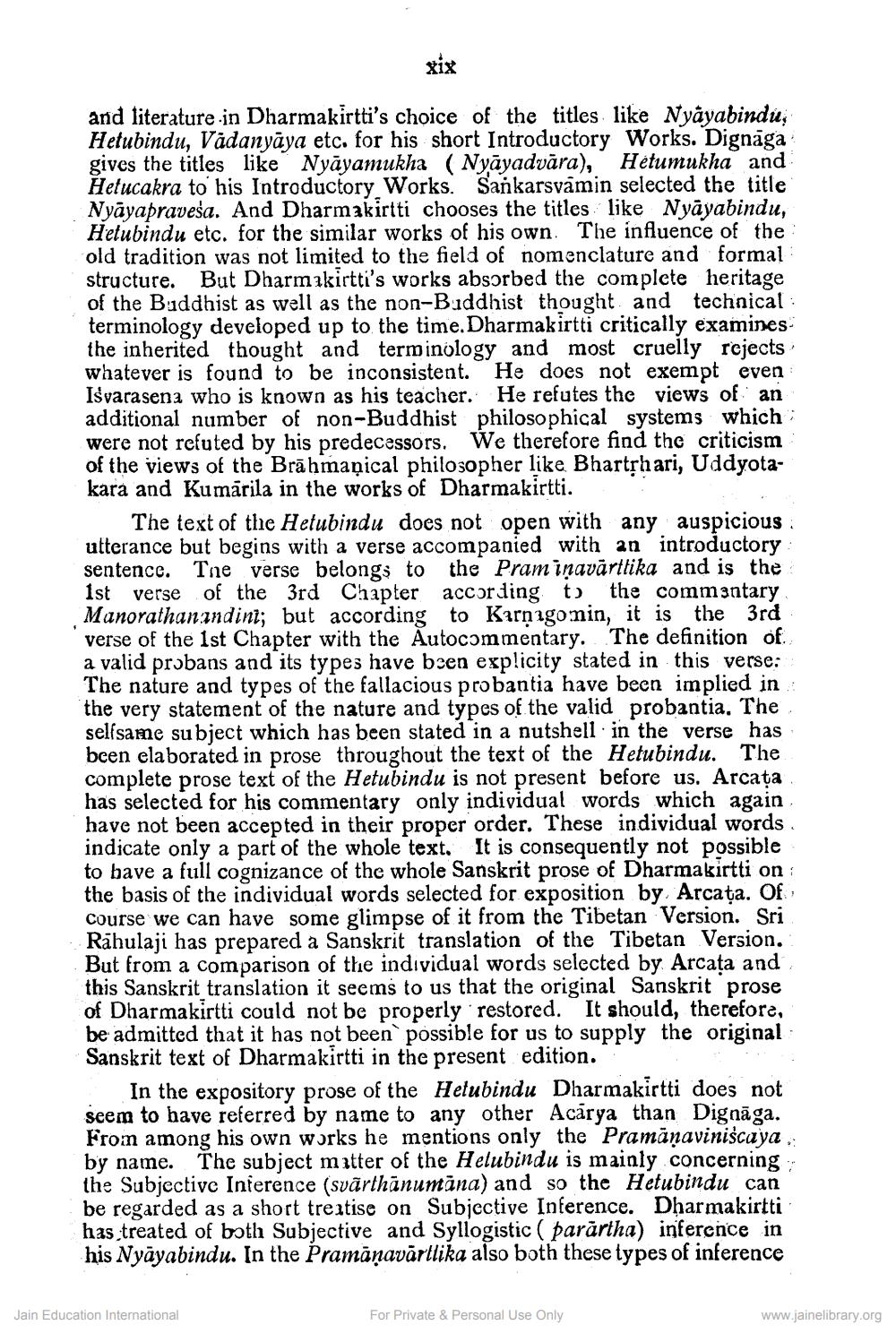________________
XIX
and literature.in Dharmakirtti's choice of the titles like Nyayabindu, Hetubindu, Vadanyāya etc. for his short Introductory Works. Dignaga gives the titles like Nyāyamukha (Nyāyadvāra), Hétumukha and Helucakra to his Introductory Works. Sankarsvamin selected the title Nyāyapravesa. And Dharmakirtti chooses the titles like Nyāyabindu, Hetubindu etc. for the similar works of his own. The influence of the old tradition was not limited to the field of nomenclature and formal structure. But Dharmakirtti's works absorbed the complete heritage of the Buddhist as well as the non-Buddhist thought and technical terminology developed up to the time. Dharmakirtti critically examines the inherited thought and terminology and most cruelly rejects whatever is found to be inconsistent. He does not exempt even Išvarasena who is known as his teacher. He refutes the views of an additional number of non-Buddhist philosophical systems which were not refuted by his predecessors. We therefore find the criticism of the views of the Brāhmaṇical philosopher like Bhartrh ari, Uddyotakara and Kumärila in the works of Dharmakirtti.
The text of the Hetubindu does not open with any auspicious utterance but begins with a verse accompanied with an introductory sentence. The verse belongs to the Pram inavārttika and is the 1st verse of the 3rd Chapter according t the communtary Manorathanındini; but according to Karnigonin, it is the 3rd verse of the 1st Chapter with the Autocommentary. The definition of a valid pröbans and its types have been explicity stated in this verse: The nature and types of the fallacious probantia have been implied in the very statement of the nature and types of the valid probantia. The selfsame subject which has been stated in a nutshell in the verse has been elaborated in prose throughout the text of the Hetubindu. The complete prose text of the Hetubindu is not present before us. Arcata has selected for his commentary only individual words which again have not been accepted in their proper order. These individual words indicate only a part of the whole text. It is consequently not possible to bave a full cognizance of the whole Sanskrit prose of Dharmakirtti on the basis of the individual words selected for exposition by Arcaţa. Of Course we can have some glimpse of it from the Tibetan Version. Sri Rahulaji has prepared a Sanskrit translation of the Tibetan Version. But from a comparison of the individual words selected by Arcata and this Sanskrit translation it seems to us that the original Sanskrit prose of Dharmakirtti could not be properly restored. It should, therefore, be admitted that it has not been possible for us to supply the original Sanskrit text of Dharmakirtti in the present edition.
In the expository prose of the Hetubindu Dharmakirtti does not seem to have referred by name to any other Acārya than Dignāga. From among his own works he mentions only the Pramanaviniscaya by name. The subject matter of the Helubindu is mainly concerning the Subjective Inference (svārthānumāna) and so the Hetubindu can be regarded as a short treatise on Subjective Inference. Dharmakirtti has treated of both Subjective and Syllogistic ( parārtha) inference in his Nyāyabindu. In the Pramāņavārtlika also both these types of inference
Jain Education International
For Private & Personal Use Only
www.jainelibrary.org




